Nova Scotia tourism offers a captivating blend of maritime history, stunning coastal scenery, and vibrant cultural experiences, making it a must-visit destination. SIXT.VN is your trusted partner for planning an unforgettable trip to Vietnam, offering comprehensive services from airport transfers to curated tours. Discover the charm and allure of Nova Scotia.
1. Understanding the Tourism Satellite Account for Nova Scotia
The Provincial and Territorial Tourism Satellite Account is crucial for understanding tourism’s economic impact. It defines “tourism industries” as those that rely heavily on tourism, such as air transportation and accommodations. “Tourism products” are goods and services significantly demanded by tourists.
1.1. What Were the Total Tourism Expenditures in Nova Scotia in 2019?
In 2019, Nova Scotia saw $2.629 billion in tourism expenditures. Tourism products accounted for $2.1542 billion, while other products purchased by tourists totaled $474.8 million. This demonstrates the significant economic contribution of tourism to the province.
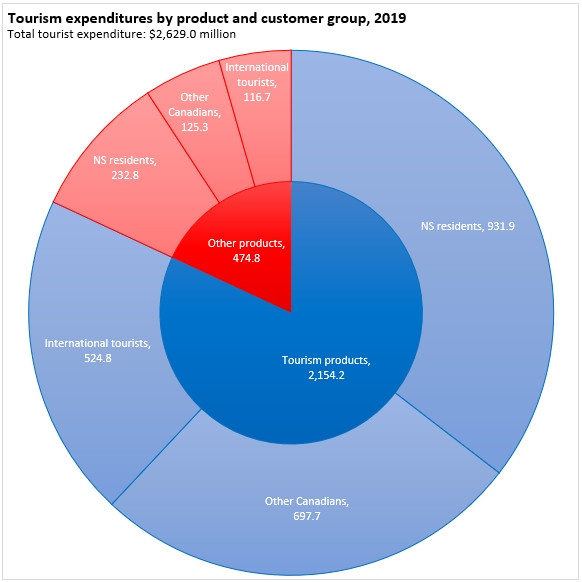
1.2. How Much Did Domestic Tourists Spend in Nova Scotia in 2019?
Nova Scotia residents spent $1.1647 billion within the province in 2019. This included $931.9 million on tourism products and $232.8 million on other products. Domestic tourism is a substantial contributor to the local economy.
1.3. What Was the Spending by Visitors from Other Provinces in 2019?
Visitors from other Canadian provinces spent $823.0 million in Nova Scotia in 2019. Of this, $697.7 million was spent on tourism products, and $125.3 million on other products. Interprovincial tourism is a vital part of Nova Scotia’s tourism revenue.
1.4. How Much Did International Visitors Spend in Nova Scotia in 2019?
International visitors contributed $641.5 million in tourism expenditures to Nova Scotia in 2019. This included $524.8 million on tourism products and $116.7 million on other products. International tourism significantly boosts the province’s economy.
2. Components of Tourism Products in Nova Scotia
Tourism products are diverse and cater to various needs. The main categories include transportation, accommodations, food and beverage services, and other tourism-related products.
2.1. What Are the Major Components of Transportation Expenditures?
Transportation expenditures primarily include air travel, fuel, vehicle repair/parts, and vehicle rentals. Efficient transportation infrastructure is crucial for tourism, enhancing accessibility and convenience for visitors.
2.2. What Types of Accommodations Are Most Popular Among Tourists?
Hotels account for the largest portion of accommodation expenditures. The availability of diverse and high-quality lodging options enhances the overall tourist experience.
2.3. How Do Food and Beverage Services Contribute to Tourism?
Restaurants make up the bulk of food and beverage service expenditures. Culinary experiences are integral to tourism, offering visitors a taste of local culture and cuisine.
2.4. What “Other Products” Are Commonly Purchased by Tourists?
Recreation and entertainment spending is significant outside of transportation, accommodation, and food/beverage services. Among specific tourism-related “other products,” groceries are the largest individual item. These contribute to the overall tourism expenditure in Nova Scotia.
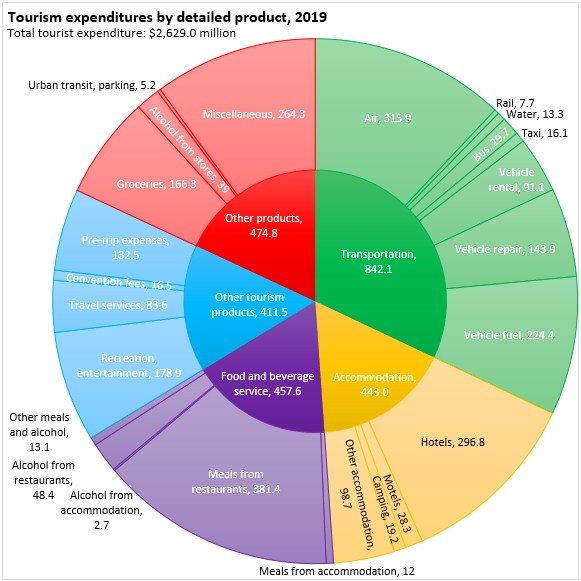
3. Economic Impact of Tourism on Nova Scotia
Tourism’s impact extends beyond direct expenditures, contributing significantly to the province’s Gross Domestic Product (GDP) and employment.
3.1. How Much Did Tourism Contribute to Nova Scotia’s GDP in 2019?
Tourism expenditures of $2,629.0 million generated a GDP of $998.1 million, representing 2.3% of Nova Scotia’s total GDP in 2019. This indicates tourism’s substantial role in the provincial economy.
3.2. How Does Nova Scotia’s Tourism GDP Compare to the Rest of Canada?
Across Canada, tourism GDP accounted for an average of 2.0% of GDP. Nova Scotia’s 2.3% share is higher than the national average, ranking among the top provinces for tourism contribution to GDP.
3.3. Which Provinces Have the Highest Tourism Share of GDP?
Prince Edward Island and British Columbia have the highest tourism share of GDP, followed by Nova Scotia. These provinces heavily rely on tourism as a key economic driver.
3.4. Which Province Has the Lowest Tourism Share of GDP?
Saskatchewan has the lowest share of tourism in GDP. This highlights the varying importance of tourism across different provinces.
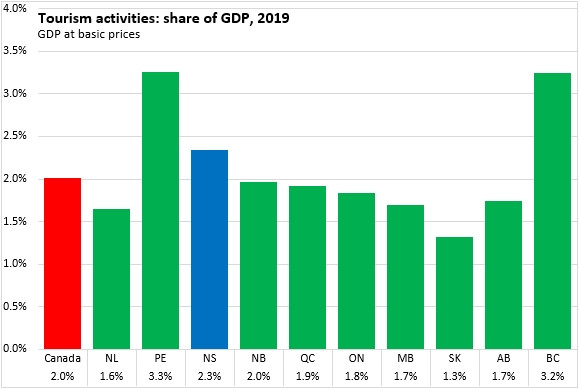
4. Tourism and Employment in Nova Scotia
Tourism is a significant employer, providing numerous jobs across various sectors within the province.
4.1. What Percentage of Total Employment in Nova Scotia Was Attributed to Tourism in 2019?
Tourism accounted for 4.4% of total employment in Nova Scotia in 2019. This figure includes both full-time and part-time positions, demonstrating tourism’s role in job creation.
4.2. How Does Nova Scotia’s Tourism Employment Compare Nationally?
Nationally, tourism accounted for 3.6% of employment. Nova Scotia’s 4.4% share is higher than the national average, reflecting the province’s strong tourism sector.
4.3. Which Provinces Have the Highest Tourism Employment Rates?
Prince Edward Island and British Columbia have the highest portion of employment in tourism, followed by Nova Scotia. These provinces have thriving tourism industries.
4.4. Which Province Has the Lowest Tourism Employment Rate?
Manitoba has the lowest share of employment attributed to tourism. This underscores regional differences in the tourism sector’s contribution to employment.
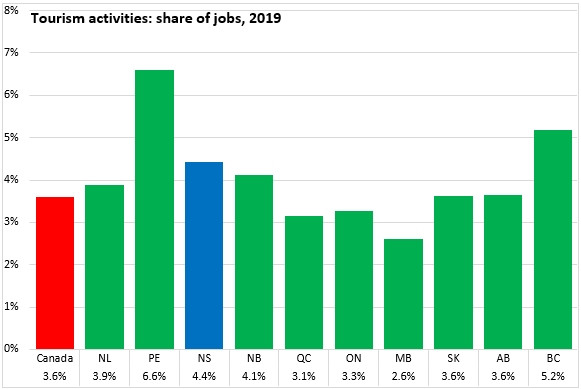
5. Labour Income Generated by Tourism
Tourism not only creates jobs but also generates substantial labour income, contributing to the financial well-being of residents.
5.1. What Percentage of Nova Scotia’s Labour Income Was Generated by Tourism in 2019?
Tourism jobs accounted for 2.7% of Nova Scotia’s labour income in 2019. This highlights the economic significance of tourism in providing income for workers.
5.2. How Does Nova Scotia Rank in Tourism-Generated Labour Income?
Nova Scotia ranks third in tourism-generated labour income, after Prince Edward Island and British Columbia. This positions Nova Scotia as a key player in tourism-related income generation.
5.3. What Is the National Average for Tourism-Generated Labour Income?
Tourism generated 2.3% of national labour income. Nova Scotia’s 2.7% share is above the national average, indicating a robust tourism-driven economy.
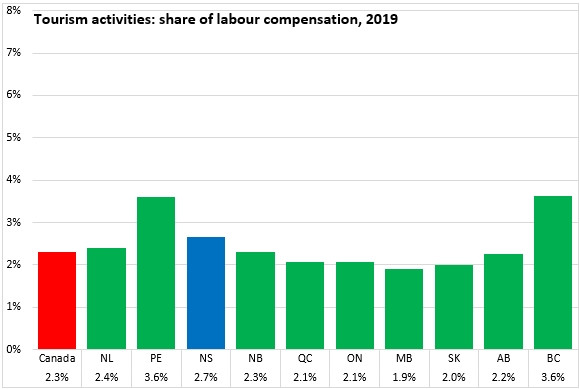
6. Characteristics of Tourism Employment
Tourism employment often differs from other sectors in terms of work arrangements and compensation levels.
6.1. Is Part-Time Employment Common in Tourism Industries?
Yes, part-time employment is more common in tourism industries than in the rest of the economy. Tourism offers flexible work opportunities for many individuals.
6.2. How Does Average Labour Income Per Tourism Job Compare to the Provincial Average?
Average labour income per tourism job was $33,200 in Nova Scotia, about 50% of the provincial average labour income per job. This indicates that tourism jobs often have lower average pay compared to other sectors.
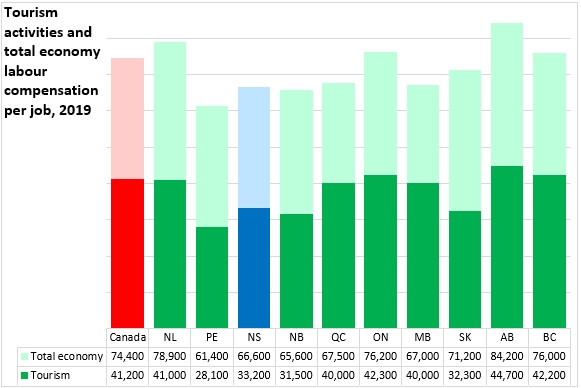
7. Sources of Tourism Demand
Understanding the sources of tourism demand helps in tailoring marketing strategies and enhancing visitor experiences.
7.1. What Percentage of Tourism Product Spending Comes from Domestic Demand?
Domestic demand, which includes travel by residents within Nova Scotia, accounted for just under half (44.3%) of tourism product spending. This highlights the importance of local tourism.
7.2. What Percentage of Tourism Product Spending Comes from Interprovincial Exports?
Interprovincial exports, representing visitors from other provinces in Canada, accounted for 31.3% of tourism product spending. These visitors significantly contribute to the province’s tourism revenue.
7.3. What Percentage of Tourism Product Spending Comes from International Exports?
International exports, which include visitors from other countries, made up 24.4% of tourism product spending. International tourists are a vital source of tourism income.
8. Provincial Variations in Tourism Expenditure
Tourism expenditure patterns vary across provinces, reflecting differences in tourism offerings and visitor demographics.
8.1. Which Province Has the Highest Domestic Share of Tourism Expenditures?
The domestic share of tourism expenditures was highest in Saskatchewan. This indicates a strong reliance on local tourism.
8.2. Which Province Has the Lowest Domestic Share of Tourism Expenditure?
The lowest domestic share of tourism expenditure was in Prince Edward Island. This suggests a greater reliance on interprovincial and international tourism.
8.3. Which Provinces Have the Highest Interprovincial Shares of Tourism Expenditures?
The interprovincial shares of tourism expenditures were highest in Prince Edward Island. This highlights the importance of visitors from other Canadian provinces.
8.4. Which Provinces Have the Lowest Interprovincial Shares of Tourism Expenditures?
Quebec and Ontario have the lowest interprovincial shares of tourism expenditures. These provinces may rely more on domestic and international tourism.
8.5. Which Provinces Have the Highest International Share of Tourism Expenditure?
British Columbia and Prince Edward Island have the highest international share of tourism expenditure. These provinces attract a significant number of international visitors.
8.6. Which Provinces Have the Lowest Shares of International Expenditures in Tourism?
Newfoundland and Labrador, Manitoba, and Saskatchewan have the lowest shares of international expenditures in tourism. These provinces may focus more on domestic and interprovincial tourism.
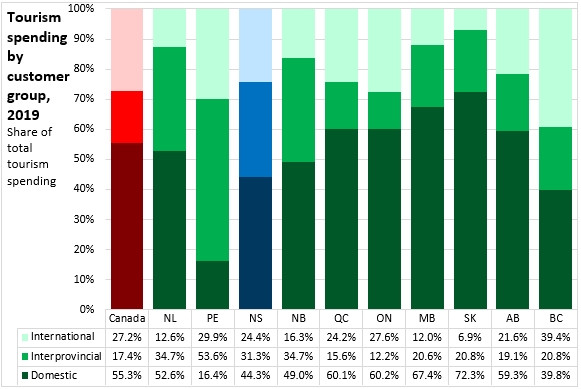
9. Tourism Spending Per Capita
Tourism spending per capita provides insights into how effectively provinces attract and retain tourism dollars.
9.1. Which Provinces Reported More Inbound Tourism Spending Per Capita Than Outbound?
Only Nova Scotia, Prince Edward Island, and British Columbia reported more inbound tourism spending per capita than outbound tourism spending by residents. This indicates these provinces are net beneficiaries of tourism.
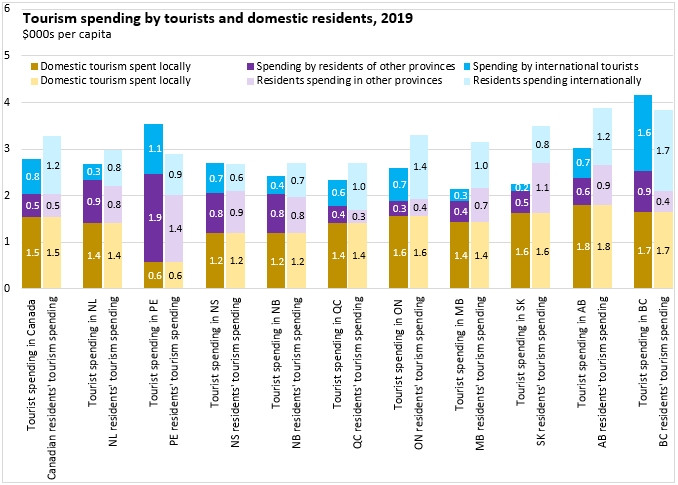
10. Top Attractions and Activities in Nova Scotia
Nova Scotia offers a wide array of attractions and activities that cater to diverse interests. Here are some must-visit spots:
10.1. What Are Some Historical Sites to Visit in Nova Scotia?
-
Halifax Citadel National Historic Site: Explore this iconic fortress and learn about its role in defending Halifax.
-
Fortress of Louisbourg National Historic Site: Step back in time at this reconstructed 18th-century French fortress.
10.2. What Are Some Natural Attractions in Nova Scotia?
-
Cabot Trail: Drive along this scenic route with breathtaking views of the coastline and highlands.
-
Peggy’s Cove: Visit this picturesque fishing village with its iconic lighthouse.
-
Bay of Fundy: Witness the world’s highest tides and explore the unique coastal landscapes.
10.3. What Are Some Cultural Experiences to Enjoy in Nova Scotia?
- Celtic Colours International Festival: Celebrate Celtic music and culture at this annual event.
- Maritime Museum of the Atlantic: Discover the maritime history of the region through fascinating exhibits.
10.4. What Outdoor Activities Can Tourists Participate In?
- Hiking and Biking: Explore numerous trails offering stunning views.
- Whale Watching: Take a boat tour to see whales in their natural habitat.
- Kayaking and Canoeing: Paddle through the province’s beautiful waterways.
11. How SIXT.VN Enhances Your Nova Scotia Tourism Experience
Planning a trip to Nova Scotia can be seamless and enjoyable with the right support. SIXT.VN offers comprehensive services designed to cater to all your travel needs.
11.1. What Travel Planning Services Does SIXT.VN Offer?
- Customized Itineraries: SIXT.VN creates personalized itineraries based on your interests and preferences.
- Airport Transfers: Enjoy hassle-free transportation from the airport to your accommodation.
- Hotel Bookings: Choose from a wide range of hotels that suit your budget and location preferences.
11.2. How Does SIXT.VN Assist with Transportation Needs?
- Car Rentals: Rent a car to explore Nova Scotia at your own pace.
- Guided Tours: Join guided tours to discover the best attractions with knowledgeable guides.
11.3. What Additional Services Does SIXT.VN Provide?
- Attraction Tickets: Pre-book tickets to popular attractions to avoid long queues.
- Travel Insurance: Ensure peace of mind with comprehensive travel insurance options.
- 24/7 Support: Access round-the-clock support for any assistance during your trip.
12. Addressing Common Challenges in Tourism
Despite its allure, tourism can present challenges. Understanding these issues helps in developing strategies for sustainable and responsible tourism.
12.1. What Are Some Environmental Challenges Related to Tourism?
- Pollution: Increased tourism can lead to higher levels of pollution, affecting natural ecosystems.
- Resource Depletion: Overuse of resources like water and energy can strain local infrastructure.
- Habitat Destruction: Construction of tourist facilities can lead to habitat loss and fragmentation.
12.2. What Are Some Socio-Cultural Challenges Related to Tourism?
- Cultural Commodification: Local cultures can be commercialized and altered to cater to tourist expectations.
- Loss of Authenticity: Traditional practices and values may be diluted or replaced by tourist-oriented activities.
- Social Disruptions: Increased tourism can lead to overcrowding, traffic congestion, and strain on local services.
12.3. How Can Sustainable Tourism Practices Mitigate These Challenges?
- Eco-Friendly Accommodations: Promoting hotels and resorts that minimize environmental impact.
- Responsible Tour Operators: Supporting tour companies that prioritize conservation and respect local cultures.
- Community Involvement: Engaging local communities in tourism planning and management to ensure benefits are shared equitably.
13. Sustainable Tourism Initiatives in Nova Scotia
Nova Scotia is committed to promoting sustainable tourism practices to protect its natural and cultural heritage.
13.1. What Are Some Eco-Certification Programs in Nova Scotia?
- Green Key Eco-Rating Program: Certifies hotels and accommodations based on their environmental performance.
- Tourism Industry Association of Nova Scotia (TIANS) Sustainability Program: Encourages businesses to adopt sustainable practices.
13.2. What Conservation Efforts Are in Place?
- Protected Areas: Establishing and managing protected areas to conserve biodiversity and natural landscapes.
- Wildlife Protection: Implementing measures to protect endangered species and their habitats.
13.3. How Are Local Communities Involved in Tourism?
- Community-Based Tourism Initiatives: Supporting tourism ventures that are owned and operated by local communities.
- Cultural Preservation Programs: Promoting and preserving local traditions, arts, and crafts through tourism.
14. Tips for Planning a Tourism Trip to Nova Scotia
Planning a successful trip involves careful consideration of various factors to ensure a smooth and enjoyable experience.
14.1. When Is the Best Time to Visit Nova Scotia?
- Summer (June-August): Warm weather and numerous outdoor activities make this a popular time.
- Fall (September-October): Enjoy vibrant fall foliage and fewer crowds.
- Spring (April-May): Witness blooming flowers and enjoy milder temperatures.
14.2. What Should You Pack for a Trip to Nova Scotia?
- Layered Clothing: Be prepared for changing weather conditions.
- Comfortable Shoes: Essential for hiking and exploring.
- Rain Gear: Pack a waterproof jacket and umbrella.
14.3. How Can You Get Around Nova Scotia?
- Car Rental: Provides flexibility and convenience for exploring the province.
- Public Transportation: Limited but available in urban areas.
- Guided Tours: Offer hassle-free transportation to popular attractions.
14.4. What Are Some Essential Travel Tips?
- Book Accommodations in Advance: Especially during peak season.
- Check Weather Forecasts: Stay updated on weather conditions.
- Respect Local Customs: Be mindful of local traditions and practices.
15. Accommodation Options in Nova Scotia
Finding the right accommodation is crucial for a comfortable and enjoyable trip.
15.1. What Types of Accommodations Are Available?
- Hotels: Range from budget-friendly to luxury options.
- Bed and Breakfasts: Offer cozy and personalized experiences.
- Vacation Rentals: Provide more space and privacy for families and groups.
- Campgrounds: Ideal for nature lovers and outdoor enthusiasts.
15.2. What Are Some Popular Hotel Chains in Nova Scotia?
- Marriott: Offers a range of hotels from budget to luxury.
- Hilton: Known for its quality and comfort.
- Holiday Inn: Provides reliable and affordable options.
15.3. Where Can You Find Unique Stays?
- Historic Inns: Experience the charm of Nova Scotia’s past.
- Coastal Cottages: Enjoy stunning ocean views.
- Farm Stays: Immerse yourself in rural life.
16. Food and Drink Experiences in Nova Scotia
Nova Scotia offers a diverse culinary scene that showcases local ingredients and flavors.
16.1. What Are Some Must-Try Local Dishes?
- Lobster: Indulge in fresh lobster dishes.
- Hodge Podge: Savor this traditional vegetable stew.
- Donair: Try Halifax’s signature street food.
- Seafood Chowder: Warm up with a creamy seafood soup.
16.2. Where Can You Find Local Markets?
- Halifax Seaport Farmers’ Market: Shop for fresh produce, artisanal goods, and local crafts.
- Lunenburg Farmers’ Market: Discover local products in this historic town.
16.3. What Are Some Local Breweries and Wineries to Visit?
- Alexander Keith’s Brewery: Take a tour of this historic brewery.
- Luckett Vineyards: Enjoy wine tasting with stunning vineyard views.
- Gaspereau Vineyards: Sample award-winning wines in the Gaspereau Valley.
17. Events and Festivals in Nova Scotia
Nova Scotia hosts numerous events and festivals throughout the year, offering unique cultural experiences.
17.1. What Are Some Popular Music Festivals?
- Celtic Colours International Festival: Celebrate Celtic music and culture.
- Halifax Jazz Festival: Enjoy jazz performances by local and international artists.
17.2. What Are Some Cultural Festivals?
- Lunenburg Folk Harbour Festival: Experience traditional folk music and culture.
- Natal Day Festival: Celebrate Halifax’s birthday with parades and events.
17.3. What Are Some Food and Drink Festivals?
- Devour! The Food Film Fest: Combine culinary delights with film screenings.
- Nova Scotia Craft Beer Week: Sample local craft beers and meet brewers.
18. Getting Around Nova Scotia: Transportation Options
Navigating Nova Scotia efficiently enhances your travel experience.
18.1. What Are the Main Airports in Nova Scotia?
- Halifax Stanfield International Airport (YHZ): The primary airport for international and domestic flights.
- Sydney Airport (YQY): Serves Cape Breton Island.
18.2. Is It Easy to Rent a Car in Nova Scotia?
Yes, car rental services are widely available at airports and in major cities.
18.3. What Public Transportation Options Are Available?
- Buses: Provide limited service in urban areas.
- Ferries: Connect various coastal communities.
18.4. Are Taxis and Ride-Sharing Services Available?
Yes, taxis and ride-sharing services are available in major cities.
19. Safety and Health Tips for Travelers
Ensuring your safety and health is paramount when traveling.
19.1. What Are Some General Safety Tips for Travelers?
- Secure Your Belongings: Keep valuables safe and avoid displaying expensive items.
- Stay Aware of Your Surroundings: Be vigilant and avoid walking alone in poorly lit areas.
- Trust Your Instincts: If a situation feels unsafe, remove yourself from it.
19.2. What Health Precautions Should You Take?
- Travel Insurance: Purchase comprehensive travel insurance to cover medical expenses.
- Vaccinations: Check with your doctor about recommended vaccinations.
- First Aid Kit: Carry a basic first aid kit with essential supplies.
19.3. What Emergency Services Are Available in Nova Scotia?
- Emergency Number: Dial 911 for police, fire, or ambulance services.
- Hospitals: Locate nearby hospitals and medical facilities.
20. Essential Phrases for Visitors
Learning a few basic phrases can enhance your interactions with locals.
20.1. What Are Some Common Greetings?
- Hello: Hello
- Good morning: Good morning
- Good evening: Good evening
20.2. What Are Some Polite Phrases?
- Please: Please
- Thank you: Thank you
- You’re welcome: You’re welcome
- Excuse me: Excuse me
20.3. How Can You Ask for Directions?
- Where is…? Where is…?
- How do I get to…? How do I get to…?
20.4. How Can You Order Food?
- I would like…: I would like…
- What do you recommend? What do you recommend?
21. Budgeting for Your Trip to Nova Scotia
Creating a budget helps you manage your expenses and make the most of your trip.
21.1. What Are Typical Accommodation Costs?
- Budget Hotels: $80 – $120 per night
- Mid-Range Hotels: $150 – $250 per night
- Luxury Hotels: $300+ per night
21.2. What Are Average Food Expenses?
- Budget Meals: $15 – $25 per meal
- Mid-Range Restaurants: $30 – $50 per meal
- Fine Dining: $75+ per meal
21.3. How Much Should You Budget for Activities and Attractions?
- Free Activities: Parks, beaches, and hiking trails
- Paid Attractions: Museums, historical sites, and tours
- Transportation: Car rental, public transport, and taxis
21.4. What Are Some Tips for Saving Money?
- Travel During Off-Season: Enjoy lower prices and fewer crowds.
- Cook Your Own Meals: Save money by preparing some of your meals.
- Take Advantage of Free Activities: Explore parks, beaches, and hiking trails.
22. Exploring Cape Breton Island
Cape Breton Island is a gem within Nova Scotia, offering stunning landscapes and unique cultural experiences.
22.1. What Are the Main Attractions on Cape Breton Island?
- Cabot Trail: A scenic drive with breathtaking views.
- Cape Breton Highlands National Park: A paradise for hikers and nature lovers.
- Fortress of Louisbourg National Historic Site: A reconstructed 18th-century French fortress.
22.2. How Can You Get to Cape Breton Island?
- Car: Drive from mainland Nova Scotia via the Canso Causeway.
- Flights: Fly into Sydney Airport (YQY).
- Ferries: Take a ferry from various coastal communities.
22.3. What Activities Can You Enjoy on Cape Breton Island?
- Hiking: Explore numerous trails with stunning views.
- Whale Watching: Take a boat tour to see whales in their natural habitat.
- Cultural Experiences: Visit museums, historical sites, and cultural centers.
23. Discovering Halifax
Halifax, the capital of Nova Scotia, is a vibrant city with rich history and modern attractions.
23.1. What Are the Main Attractions in Halifax?
- Halifax Citadel National Historic Site: Explore this iconic fortress.
- Waterfront Boardwalk: Stroll along the scenic waterfront.
- Maritime Museum of the Atlantic: Discover the maritime history of the region.
- Public Gardens: Relax in this beautiful Victorian-era garden.
23.2. How Can You Get Around Halifax?
- Public Transportation: Buses and ferries provide service throughout the city.
- Taxis and Ride-Sharing Services: Available for convenient transportation.
- Walking: Explore the downtown area on foot.
23.3. What Activities Can You Enjoy in Halifax?
- Historical Tours: Learn about the city’s rich history.
- Shopping: Explore boutiques and shops on Spring Garden Road.
- Dining: Enjoy diverse culinary experiences in the city’s restaurants.
24. Exploring the Bay of Fundy
The Bay of Fundy is renowned for its dramatic tides and unique coastal landscapes.
24.1. What Makes the Bay of Fundy Unique?
- Highest Tides in the World: Witness the world’s highest tides.
- Unique Coastal Landscapes: Explore sea stacks, cliffs, and beaches.
- Abundant Marine Life: See whales, dolphins, and seabirds.
24.2. Where Are the Best Places to Experience the Bay of Fundy?
- Hopewell Rocks: Walk on the ocean floor during low tide and see the famous flowerpot rocks.
- Fundy National Park: Hike along coastal trails and enjoy stunning views.
- Digby: A charming fishing town known for its scallop fleet.
24.3. What Activities Can You Enjoy in the Bay of Fundy?
- Tidal Bore Rafting: Experience the thrill of riding the tidal bore.
- Whale Watching Tours: See whales in their natural habitat.
- Hiking: Explore coastal trails with stunning views.
25. Contact SIXT.VN for Your Tourism Needs
Planning a trip to Nova Scotia or Vietnam? SIXT.VN is here to help.
25.1. What Services Does SIXT.VN Offer?
- Customized Itineraries: Tailored to your interests and preferences.
- Airport Transfers: Hassle-free transportation to and from the airport.
- Hotel Bookings: Wide range of options to suit your budget.
- Guided Tours: Discover the best attractions with knowledgeable guides.
- Attraction Tickets: Pre-book tickets to avoid long queues.
- Travel Insurance: Comprehensive coverage for peace of mind.
25.2. How Can You Contact SIXT.VN?
- Address: 260 Cau Giay, Hanoi, Vietnam
- Hotline/WhatsApp: +84 986 244 358
- Website: SIXT.VN
FAQ: Tourism in Nova Scotia
Q1: What is the best time to visit Nova Scotia?
The best time to visit Nova Scotia is during the summer (June-August) for warm weather and outdoor activities or in the fall (September-October) for vibrant foliage and fewer crowds.
Q2: What are the must-see attractions in Nova Scotia?
Must-see attractions in Nova Scotia include the Cabot Trail, Halifax Citadel National Historic Site, Peggy’s Cove, and the Bay of Fundy.
Q3: How can I get around Nova Scotia?
You can get around Nova Scotia by renting a car, using public transportation (buses and ferries), or joining guided tours.
Q4: What are some popular local dishes to try in Nova Scotia?
Popular local dishes to try in Nova Scotia include lobster, hodge podge, donair, and seafood chowder.
Q5: Are there any unique cultural experiences in Nova Scotia?
Yes, unique cultural experiences in Nova Scotia include the Celtic Colours International Festival and the Lunenburg Folk Harbour Festival.
Q6: How can I plan a sustainable tourism trip to Nova Scotia?
You can plan a sustainable tourism trip by choosing eco-friendly accommodations, supporting responsible tour operators, and participating in community-based tourism initiatives.
Q7: What are some safety tips for traveling in Nova Scotia?
General safety tips include securing your belongings, staying aware of your surroundings, and purchasing travel insurance.
Q8: How can SIXT.VN help with my travel plans to Nova Scotia?
SIXT.VN offers customized itineraries, airport transfers, hotel bookings, guided tours, and travel insurance to enhance your trip.
Q9: What are the main airports in Nova Scotia?
The main airports in Nova Scotia are Halifax Stanfield International Airport (YHZ) and Sydney Airport (YQY).
Q10: What is the best way to experience the Bay of Fundy?
The best way to experience the Bay of Fundy is by visiting Hopewell Rocks, exploring Fundy National Park, and taking a tidal bore rafting tour.



